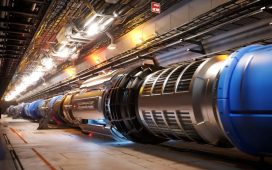It’s one of the biggest unanswered questions in science – if there’s life beyond Earth, where is it?
Now, researchers from the University of Cambridge have narrowed down the search by identifying the right conditions for comets to deliver life-starting molecules.
It has long been believed that the building blocks for life may have been delivered to Earth on a comet, and now research suggests that this could happen to other planets in the Milky Way.
‘Bouncing’ comets are slowed down as they pass from planet to planet, ensuring the necessary molecules can survive the impact.
Scientists say the best place to look for extraterrestrial life is in the habitable zone of ‘peas in a pod’ systems where the planets are closely bunched together.

Comets contain ‘prebiotic’ compounds which form the building blocks of life and could have delivered them to Earth

Planets in the habitable zone where liquid water can exist may have been given the necessary prebiotic compounds as comets bounced inwards from beyond the planetary system
Comets, frozen chunks of rock and ice, are often rich in the prebiotic compounds which can form the building blocks for organic life.
For example, samples taken from the Ryugu asteroid by a Japanese probe in 2022 were found to contain intact amino acids and vitamin B3.
Comets also contain large amounts of Hydrogen Cyanide (HCN) which, despite its deadly-sounding name, is an important molecule for the basis of life.
‘We’re learning more about the atmospheres of exoplanets all the time, so we wanted to see if there are planets where complex molecules could also be delivered by comets,’ says the study’s lead author Richard Anslow of the University of Cambridge.
‘It’s possible that the molecules that led to life on Earth came from comets, so the same could be true for planets elsewhere in the galaxy.’

Soil samples of the Ryugu asteroid were found to contain over 20 different amino acids as well as vitamin B3, these could have formed the basis of life on a planet like Earth
However, comets need to be travelling at less than 9.3 miles per second (15km/s) in order for the compounds to survive the heat and force of a planetary impact.
For smaller planets like Earth, minimum impact speeds can exceed 12.4 miles per second (20km/s), at which point only 0.2 per cent of the HCN survives.
However, the researchers found that comets could be slowed down to the correct speed if they are passed along a chain of outer planets.
The conditions are best in so-called ‘peas in a pod’ systems in which the planets orbit their star in a tight group, rather than spreading out across the orbital plane.
‘In these tightly-packed systems, each planet has a chance to interact with and trap a comet,’ said Mr Anslow.
‘It’s possible that this mechanism could be how prebiotic molecules end up on planets.’
The researchers found that this effect was most important for low-mass stars, known as M-dwarf stars, which make up 70 per cent of the stars in the region around our Sun.
The typical impact speeds around lower-mass stars tend to be higher, meaning comets need to be slowed down even more to ensure the materials can be delivered.
The larger a planet, however, the lower the chance of prebiotic molecules being delivered as larger planets have a higher escape velocity.

In our solar system, comets are pulled in from beyond the orbit of Neptune towards the Sun where they are pulled into the inner solar system by the gravity of Jupiter
The researchers therefore note that Mars would have been more likely to receive a larger and more complex set of molecules from comets as its mass is about half that of Earth’s.
This finding will allow scientists to narrow down the selection of planets where life might be found.
‘It’s exciting that we can start identifying the type of systems we can use to test different origin scenarios,’ says Mr Anslow.
‘It’s a different way to look at the great work that’s already been done on Earth. What molecular pathways led to the enormous variety of life we see around us? Are there other planets where the same pathways exist?’
For example, the study’s authors compare the stars Proxima Centauri and TRAPPIST-1 for how likely they may be to contain life.


This study will help us narrow down the search for life as systems with densely packed planets like TRAPPIST-1 (Left) are more likely to slow down comets than sparse systems like Proxima Centauri (Right)
Although Proxima Centauri, a low-mass star closest star to our Sun, has a planet in its habitable zone, there is only one other planet in the system that might slow an incoming comet.
Meanwhile, TRAPPIST-1, a cool red dwarf 40.66 light years from the Sun, has three Earth-like planets in the habitable zone and a tightly packed planetary system.
Mr Anslow and his co-authors write that ‘this resulting architecture would lead to significantly higher impact velocities when compared to the TRAPPIST-1 planets.
‘This would, in turn, dramatically reduce the efficiency of any cometary delivery.’











